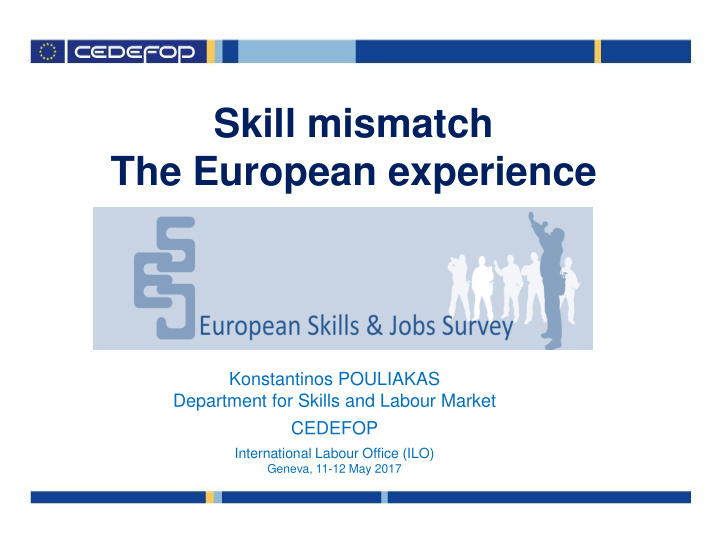



Skill mismatch The European experience Konstantinos POULIAKAS Department for Skills and Labour Market CEDEFOP International Labour Office (ILO) Geneva, 11-12 May 2017
Cedefop skill mismatch agenda Five priority areas (2008) Improve measurement of skills/skill mismatch Examine skill mismatch persistence and impacts Improve understanding of processes and dynamics Focus on skill mismatch of vulnerable groups Improve data availability and use 2009-2017 Multiple reports and briefings Inputs to European Commission/WEF New EU-level data collection (European skills and jobs survey) Online database of skill mismatch policies 2
Despite being the generation with the highest education attainment ever, today's young have paid the highest price for the crisis … However, high levels of unemployment co-exist with 2 million unfilled vacancies, an indicator that some people lack the right skills or mobility . (Commissioner M. Thyssen, ‘Avoiding a lost generation’ , 19 Jan 2015) 3
Skills shortages in EU • About 4 in 10 employers in EU have difficulty filling vacancies with right skills (3 rd European company survey) - Pronounced in Baltic states, AT, BE, HU, BG, MT, DE - Low in south-east Europe ES, EL, HR, CY • Structural shifts in EU Beveridge curves (ECB, 2012) • High- or medium-skilled bottleneck jobs e.g. ICT, health, green jobs, skilled trades • Low skills/skill gaps of those out of work (OECD, 2013; Cedefop, 2015) • Evidence of 70 million low-skilled EU individuals (OECD, 2013)
Few ‘genuine’ skill shortage vacancies ‘Genuine’ skill shortage (12%) HRM inefficiency (13%) Lack of applicants with right skills and No competitive graduate training capabilities program/slow hiring process/limited resources to market vacancies Uncompetitive wages (29%) ‘Apparent’ skill shortage (46%) Inability to offer a competitive - Lack of right skills salary & and inability to offer competitive wage (24%) & HRM inefficiency (22%) Source : Cedefop (2015) Skill shortages and skill gaps in European enterprises
Skill shortages: more than meets the eye Country-level Enterprise-level Probability of high-skill bottleneck, 2013, EU28 Finance & business Skill supply % female workforce Wholesale/retail Business cycle Atypical hours Changing workplace Employer talent Casual workforce management practices Training Health & social work Labour market Private sector Institutions % staff worked overtime -0.2 -0.15 -0.1 -0.05 0 0.05 0.1 Source : Cedefop (2015) Skill shortages and skill gaps in European enterprises
Skill mismatch, lifelong Overskilled but skill deficit? Skills obsolescence Underskilled Overqualified Skill gaps 7
Some ongoing convergence among EU countries/generations (Chlon- Dominczak et al., 2016; McGuinness et al., 2017) Country differences: unemployment, VET, female participation, EPL?, product market/housing regulations 20% 15% 10% 29% qualification mismatch 5% ~16-17% overqualified; 29% tertiary ~ 45% skill mismatch 0 24-29 30-39 40-54 55-65 Young: qualifications, low skills % underqualified % overqualified % with skill gaps Older: skilled, low qualifications Sourc e: Cedefop European skills and jobs survey (ESJS)
Skill mismatch: churn between & within jobs 100% 5% 22% 10% 80% 54% 60% 52% 40% of matched 50% 40% 20% 39% 28% 27% 0% Previous job Start of job Current post NA Skills lower than needed by job and need to develop further Skills matched to what job needs Skills higher than needed to do job Sourc e: Cedefop European skills and jobs survey (ESJS) http://www.cedefop.europa.eu/en/events-and-projects/projects/european-skills-and-jobs-esj-survey
Who are the mismatched workers? Overskilled Underskilled Mismatch: Problem-solving Mismatch: Technical skills Mismatch: Learning to learn Mismatch: ICT skills Mismatch: Basic literacy Mismatch: Planning skills Few job opportunities Motive: gain work experience Financial constraints Financial constraints Motive: job security Learning tasks Motive: career prospects Fixed-term contract Frequent learning tasks Manufacturing No routine tasks Scientific activities Part-time Managers/professionals Accommodation and food Before unemployed Plant and machine operators Before inactive Elementary jobs Low educated Male Tenure: > 5 years High educated Age: 55-65 0.00 1.00 2.00 3.00 0.00 1.00 2.00 3.00 Sourc e: Cedefop European skills and jobs survey (ESJS); graphs show estimated odds ratios, adult workers, EU28 http://www.cedefop.europa.eu/en/events-and-projects/projects/european-skills-and-jobs-esj-survey
Overqualified wage penalty: low work skills, information gaps, bad job quality Decomposition of raw wage gap between overqualified and matched tertiary graduates, 2014, EU28 Human capital (14%) Information asymmetry (11%) Unexplained (Part of wage gap due Assignment to low-skill to differential returns to jobs (7%) characteristics of overqualified or other Compensating residual factors) attributes (5%) (56%) Mobility and career concerns (2%) Other search Country differences constraints (5%) 11 Source : McGuinness & Pouliakas (2016) based on Cedefop European skills and jobs survey (ESJS)
Sustained skills matching is intertwined with high informal learning in good jobs 22% of EU adult workers have not Drivers of skill growth developed their skills further in their jobs 69% interacting 9 with colleagues at work 8.5 63% attended training courses 8 59% trial and error 7.5 51% self-training 40% supervisor 7 taught on the job 0 10 20 30 Years with current employer Non-complex job Complex job Source : Cedefop ESJS Fitted values non-complex Fitted values complex
Elements of EU skills matching policies o Include skills matching in ALMPs o Workplace learning as part of adult training o Well-defined link between skill needs anticipation and (regional) policies o Tailored training to learner skill needs (vouchers) o Include relevant stakeholders in curricula design o ICT competence-based matching o Web-based feedback of ALMPs o Strong link of ALMPs and education tools (validation) o One stop shop guidance centres o Networking teachers-business o Skills as asset for FDI Source : Cedefop (2015) Tackling unemployment while addressing skill mismatch ; skills matching policies database
EU skills matching policies Road ahead Improve skills matching activation services Improve skills intelligence and information for better guidance and career choices Improve skills governance – partnerships between multiple stakeholders (education, industry, social partners) Incentive local development or industrial policies in close alignment with skills policies Combine skills, activation, employment and mobility policies with product market, housing & other social policies
For more information Konstantinos.Pouliakas@cedefop.europa.eu www.cedefop.europa.eu 15
Recommend
More recommend